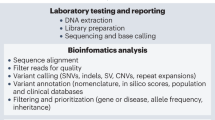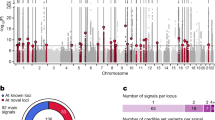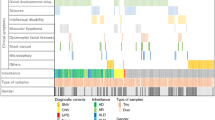Key Points
-
Exome sequencing in rare familial endocrine syndromes has led to the identification of many disease-associated genes and unravelled new biological pathways
-
In large, population-based cohorts, the use of exome sequencing has identified common, low-risk genetic variants that contribute to common diseases such as type 2 diabetes mellitus and hyperlipidaemia
-
Exome sequencing has provided insights into the pathogenesis of neuroendocrine tumours
-
Exome sequencing has also been used to implicate increased protein kinase A activity in the development of Cushing syndrome and somatic ion channel defects in primary hyperaldosteronism
-
With lowering costs, increasing availability and high diagnostic yield, the use of exome sequencing in the care of patients with endocrine diseases is expected to increase rapidly in the coming years
Abstract
Whole-exome sequencing has emerged as a fast and effective tool for the elucidation of genetic defects underlying both rare and common human diseases. Increased availability and decreased costs of next-generation sequencing have enabled investigators to use this approach not only in individual patients with rare diseases, but also to screen large cohorts or populations for the genetic determinants of diseases. Within the field of endocrinology, exome sequencing has led to major advancements in our understanding of many disorders including adrenal disease, growth and puberty disorders and type 2 diabetes mellitus, as well as a multitude of rare genetic syndromes with prominent endocrine involvement. In this Review, we provide an overview of these new insights and discuss the role that exome sequencing is expected to have in endocrine research and future clinical practice.
This is a preview of subscription content, access via your institution
Access options
Subscribe to this journal
Receive 12 print issues and online access
$209.00 per year
only $17.42 per issue
Buy this article
- Purchase on Springer Link
- Instant access to full article PDF
Prices may be subject to local taxes which are calculated during checkout


Similar content being viewed by others
References
Lander, E. S. et al. Initial sequencing and analysis of the human genome. Nature 409, 860–921 (2001).
Bamshad, M. J. et al. Exome sequencing as a tool for Mendelian disease gene discovery. Nat. Rev. Genet. 12, 745–755 (2011).
Biesecker, L. G. & Green, R. C. Diagnostic clinical genome and exome sequencing. N. Engl. J. Med. 371, 1170 (2014).
Biesecker, L. G., Shianna, K. V. & Mullikin, J. C. Exome sequencing: the expert view. Genome Biol. 12, 128 (2011).
Ng, S. B. et al. Exome sequencing identifies MLL2 mutations as a cause of Kabuki syndrome. Nat. Genet. 42, 790–793 (2010).
Dunkel, L. & Quinton, R. Transition in endocrinology: induction of puberty. Eur. J. Endocrinol. 170, R229–R239 (2014).
Abreu, A. P. et al. Central precocious puberty caused by mutations in the imprinted gene MKRN3. N. Engl. J. Med. 368, 2467–2475 (2013).
Macedo, D. B. et al. Central precocious puberty that appears to be sporadic caused by paternally inherited mutations in the imprinted gene makorin ring finger 3. J. Clin. Endocrinol. Metab. 99, E1097–E1103 (2014).
Forni, P. E. & Wray, S. GnRH, anosmia and hypogonadotropic hypogonadism—where are we? Front. Neuroendocrinol. 36C, 165–177 (2015).
Kotan, L. D. et al. Mutations in FEZF1 cause Kallmann syndrome. Am. J. Hum. Genet. 95, 326–331 (2014).
Eckler, M. J., McKenna, W. L., Taghvaei, S., McConnell, S. K. & Chen, B. Fezf1 and Fezf2 are required for olfactory development and sensory neuron identity. J. Comp. Neurol. 519, 1829–1846 (2011).
Shi, C. H. et al. Ataxia and hypogonadism caused by the loss of ubiquitin ligase activity of the U box protein CHIP. Hum. Mol. Genet. 23, 1013–1024 (2014).
Synofzik, M. et al. PNPLA6 mutations cause Boucher–Neuhauser and Gordon Holmes syndromes as part of a broad neurodegenerative spectrum. Brain 137, 69–77 (2014).
Topaloglu, A. K. et al. Loss of function mutations in PNPLA6 encoding neuropathy target esterase underlie pubertal failure and neurological deficits in Gordon Holmes syndrome. J. Clin. Endocrinol. Metab. 99, E2067–E2075 (2014).
Margolin, D. H. et al. Ataxia, dementia, and hypogonadotropism caused by disordered ubiquitination. N. Engl. J. Med. 368, 1992–2003 (2013).
Zangen, D. et al. XX ovarian dysgenesis is caused by a PSMC3IP/HOP2 mutation that abolishes coactivation of estrogen-driven transcription. Am. J. Hum. Genet. 89, 572–579 (2011).
Caburet, S. et al. Mutant cohesin in premature ovarian failure. N. Engl. J. Med. 370, 943–949 (2014).
Kasippillai, T. et al. Mutations in eIF4ENIF1 are associated with primary ovarian insufficiency. J. Clin. Endocrinol. Metab. 98, E1534–E1539 (2013).
de Vries, L. et al. Exome sequencing reveals SYCE1 mutation associated with autosomal recessive primary ovarian insufficiency. J. Clin. Endocrinol. Metab. 99, E2129–E2132 (2014).
Meimaridou, E. et al. Familial glucocorticoid deficiency: new genes and mechanisms. Mol. Cell. Endocrinol. 371, 195–200 (2013).
Meimaridou, E. et al. Mutations in NNT encoding nicotinamide nucleotide transhydrogenase cause familial glucocorticoid deficiency. Nat. Genet. 44, 740–742 (2012).
Prasad, R. et al. Thioredoxin reductase 2 (TXNRD2) mutation associated with familial glucocorticoid deficiency (FGD). J. Clin. Endocrinol. Metab. 99, E1556–E1563 (2014).
Hughes, C. R. et al. MCM4 mutation causes adrenal failure, short stature, and natural killer cell deficiency in humans. J. Clin. Invest. 122, 814–820 (2012).
Meimaridou, E. et al. ACTH resistance: genes and mechanisms. Endocr. Dev. 24, 57–66 (2013).
Masai, H., You, Z. & Arai, K. Control of DNA replication: regulation and activation of eukaryotic replicative helicase, MCM. IUBMB Life 57, 323–335 (2005).
Sun, Y. et al. Loss-of-function mutations in IGSF1 cause an X-linked syndrome of central hypothyroidism and testicular enlargement. Nat. Genet. 44, 1375–1381 (2012).
Joustra, S. D. et al. The IGSF1 deficiency syndrome: characteristics of male and female patients. J. Clin. Endocrinol. Metab. 98, 4942–4952 (2013).
Joustra, S. D. et al. IGSF1 deficiency syndrome: a newly uncovered endocrinopathy. Rare Dis. 1, e24883 (2013).
Mazzarella, R., Pengue, G., Jones, J., Jones, C. & Schlessinger, D. Cloning and expression of an immunoglobulin superfamily gene (IGSF1) in Xq25. Genomics 48, 157–162 (1998).
Kuhnen, P. et al. Identification of PENDRIN (SLC26A4) mutations in patients with congenital hypothyroidism and “apparent” thyroid dysgenesis. J. Clin. Endocrinol. Metab. 99, E169–E176 (2014).
Manolio, T. A. Genome-wide association studies and assessment of the risk of disease. N. Engl. J. Med. 363, 166–176 (2010).
SIGMA Type 2 Diabetes Consortium. Association of a low-frequency variant in HNF1A with type 2 diabetes in a Latino population. JAMA 311, 2305–2314 (2014).
Lange, L. A. et al. Whole-exome sequencing identifies rare and low-frequency coding variants associated with LDL cholesterol. Am. J. Hum. Genet. 94, 233–245 (2014).
Rosenthal, E. A. et al. Joint linkage and association analysis with exome sequence data implicates SLC25A40 in hypertriglyceridemia. Am. J. Hum. Genet. 93, 1035–1045 (2013).
Pagliarini, D. J. et al. A mitochondrial protein compendium elucidates complex I disease biology. Cell 134, 112–123 (2008).
Musunuru, K. et al. Exome sequencing, ANGPTL3 mutations, and familial combined hypolipidemia. N. Engl. J. Med. 363, 2220–2227 (2010).
Koishi, R. et al. Angptl3 regulates lipid metabolism in mice. Nat. Genet. 30, 151–157 (2002).
Abifadel, M. et al. Mutations in PCSK9 cause autosomal dominant hypercholesterolemia. Nat. Genet. 34, 154–156 (2003).
Cohen, J. et al. Low LDL cholesterol in individuals of African descent resulting from frequent nonsense mutations in PCSK9. Nat. Genet. 37, 161–165 (2005).
Farnier, M. PCSK9: From discovery to therapeutic applications. Arch. Cardiovasc. Dis. 107, 58–66 (2014).
Albrechtsen, A. et al. Exome sequencing-driven discovery of coding polymorphisms associated with common metabolic phenotypes. Diabetologia 56, 298–310 (2013).
Lohmueller, K. E. et al. Whole-exome sequencing of 2,000 Danish individuals and the role of rare coding variants in type 2 diabetes. Am. J. Hum. Genet. 93, 1072–1086 (2013).
Steinthorsdottir, V. et al. Identification of low-frequency and rare sequence variants associated with elevated or reduced risk of type 2 diabetes. Nat. Genet. 46, 294–298 (2014).
Kushner, J. A. et al. Cyclins D2 and D1 are essential for postnatal pancreatic β-cell growth. Mol. Cell Biol. 25, 3752–3762 (2005).
Maestro, M. A. et al. Distinct roles of HNF1β, HNF1α, and HNF4α in regulating pancreas development, β-cell function and growth. Endocr. Dev. 12, 33–45 (2007).
Wood, A. R. et al. Defining the role of common variation in the genomic and biological architecture of adult human height. Nat. Genet. 46, 1173–1186 (2014).
Chan, Y. et al. Common variants show predicted polygenic effects on height in the tails of the distribution, except in extremely short individuals. PLoS Genet. 7, e1002439 (2011).
Nilsson, O. et al. Short stature, accelerated bone maturation, and early growth cessation due to heterozygous aggrecan mutations. J. Clin. Endocrinol. Metab. 99, E1510–E1518 (2014).
van Dijk, F. S. et al. PLS3 mutations in X-linked osteoporosis with fractures. N. Engl. J. Med. 369, 1529–1536 (2013).
Laine, C. M. et al. A novel splice-mutation in PLS3 causes X-linked early-onset low-turnover osteoporosis. J. Bone Miner. Res. 30, 510–518 (2014).
Thomas, F., Desmedt, C., Aftimos, P. & Awada, A. Impact of tumor sequencing on the use of anticancer drugs. Curr. Opin. Oncol. 26, 347–356 (2014).
Sahakitrungruang, T. et al. Germline and somatic DICER1 mutations in a pituitary blastoma causing infantile onset Cushing disease. J. Clin. Endocrinol. Metab. 99, E1487–E1492 (2014).
Goh, G. et al. Recurrent activating mutation in PRKACA in cortisol-producing adrenal tumors. Nat. Genet. 46, 613–617 (2014).
Sato, Y. et al. Recurrent somatic mutations underlie corticotropin-independent Cushing's syndrome. Science 344, 917–920 (2014).
Cao, Y. et al. Activating hotspot L205R mutation in PRKACA and adrenal Cushing's syndrome. Science 344, 913–917 (2014).
Beuschlein, F. et al. Constitutive activation of PKA catalytic subunit in adrenal Cushing's syndrome. N. Engl. J. Med. 370, 1019–1028 (2014).
Assie, G. et al. Integrated genomic characterization of adrenocortical carcinoma. Nat. Genet. 46, 607–612 (2014).
Assie, G. et al. ARMC5 mutations in macronodular adrenal hyperplasia with Cushing's syndrome. N. Engl. J. Med. 369, 2105–2114 (2013).
Gagliardi, L. et al. ARMC5 mutations are common in familial bilateral macronodular adrenal hyperplasia. J. Clin. Endocrinol. Metab. 99, E1784–E1792 (2014).
Tissier, F. et al. Mutations of β-catenin in adrenocortical tumors: activation of the Wnt signaling pathway is a frequent event in both benign and malignant adrenocortical tumors. Cancer Res. 65, 7622–7627 (2005).
Fagugli, R. M. & Taglioni, C. Changes in the perceived epidemiology of primary hyperaldosteronism. Int. J. Hypertens. 2011, 162804 (2011).
Al-Salameh, A., Cohen, R. & Desailloud, R. Overview of the genetic determinants of primary aldosteronism. Appl. Clin. Genet. 7, 67–79 (2014).
Conn, J. W. & Louis, L. H. Primary aldosteronism: a new clinical entity. Trans. Assoc. Am. Physicians 68, 215–231 (1955).
Choi, M. et al. K+ channel mutations in adrenal aldosterone-producing adenomas and hereditary hypertension. Science 331, 768–772 (2011).
Monticone, S. et al. A Novel Y152C KCNJ5 mutation responsible for familial hyperaldosteronism type III. J. Clin. Endocrinol. Metab. 98, E1861–E1865 (2013).
Beuschlein, F. et al. Somatic mutations in ATP1A1 and ATP2B3 lead to aldosterone-producing adenomas and secondary hypertension. Nat. Genet. 45, 440–444 (2013).
Azizan, E. A. et al. Somatic mutations in ATP1A1 and CACNA1D underlie a common subtype of adrenal hypertension. Nat. Genet. 45, 1055–1060 (2013).
Newey, P. J. et al. Whole-exome sequencing studies of nonhereditary (sporadic) parathyroid adenomas. J. Clin. Endocrinol. Metab. 97, E1995–E2005 (2012).
Cromer, M. K. et al. Identification of somatic mutations in parathyroid tumors using whole-exome sequencing. J. Clin. Endocrinol. Metab. 97, E1774–E1781 (2012).
Newey, P. J. et al. Whole-exome sequencing studies of nonfunctioning pituitary adenomas. J. Clin. Endocrinol. Metab. 98, E796–E800 (2013).
Cao, M. et al. Analysis of the inheritance pattern of a Chinese family with phaeochromocytomas through whole exome sequencing. Gene 526, 164–169 (2013).
Cao, Y. et al. Whole exome sequencing of insulinoma reveals recurrent T372R mutations in YY1. Nat. Commun. 4, 2810 (2013).
Foulkes, W. D., Priest, J. R. & Duchaine, T. F. DICER1: mutations, microRNAs and mechanisms. Nat. Rev. Cancer 14, 662–72 (2014).
Guo, M. H. et al. Whole exome sequencing to identify genetic causes of short stature. Horm. Res. Paediatr. 82, 44–52 (2014).
Unger, S. et al. FAM111A mutations result in hypoparathyroidism and impaired skeletal development. Am. J. Hum. Genet. 92, 990–995 (2013).
Biesecker, L. G. & Green, R. C. Diagnostic clinical genome and exome sequencing. N. Engl. J. Med. 370, 2418–2425 (2014).
1000 Genomes Project [online], (2014).
NHLBI Exome Sequencing Project. Exome variant server [online], (2015).
Exome Aggregation Consortium ExAC Browser (Beta) [online], (2015).
Wang, G. T., Peng, B. & Leal, S. M. Variant association tools for quality control and analysis of large-scale sequence and genotyping array data. Am. J. Hum. Genet. 94, 770–783 (2014).
Flannick, J. et al. Assessing the phenotypic effects in the general population of rare variants in genes for a dominant Mendelian form of diabetes. Nat. Genet. 45, 1380–1385 (2013).
Green, R. C. et al. ACMG recommendations for reporting of incidental findings in clinical exome and genome sequencing. Genet. Med. 15, 565–574 (2013).
Smith, L. A., Douglas, J., Braxton, A. A. & Kramer, K. Reporting incidental findings in clinical whole exome sequencing: incorporation of the 2013 ACMG recommendations into current practices of genetic counseling. J. Genet. Couns. http://dx.doi.org/10.1007/s10897-014-9794-4.
Yang, Y. et al. Clinical whole-exome sequencing for the diagnosis of Mendelian disorders. N. Engl. J. Med. 369, 1502–1511 (2013).
Yang, Y. et al. Molecular findings among patients referred for clinical whole-exome sequencing. JAMA 312, 1870–1879 (2014).
Lee, H. et al. Clinical exome sequencing for genetic identification of rare Mendelian disorders. JAMA 312, 1880–1887 (2014).
Baxter, R. M. et al. Exome sequencing for the diagnosis of 46,XY disorders of sex development. J. Clin. Endocrinol. Metab. 100, E333–E344 (2014).
Waldman, L. A. & Chia, D. J. Towards identification of molecular mechanisms of short stature. Int. J. Pediatr. Endocrinol. 2013, 19 (2013).
Dauber, A., Rosenfeld, R. G. & Hirschhorn, J. N. Genetic evaluation of short stature. J. Clin. Endocrinol. Metab. 99, 3080–3092 (2014).
Samuels, M. E. et al. Bioinactive ACTH causing glucocorticoid deficiency. J. Clin. Endocrinol. Metab. 98, 736–742 (2013).
Tegtmeyer, L. C. et al. Multiple phenotypes in phosphoglucomutase 1 deficiency. N. Engl. J. Med. 370, 533–542 (2014).
Webb, E. A. et al. ARNT2 mutation causes hypopituitarism, post-natal microcephaly, visual and renal anomalies. Brain 136, 3096–3105 (2013).
Dauber, A. et al. Genetic defect in CYP24A1, the vitamin D 24-hydroxylase gene, in a patient with severe infantile hypercalcemia. J. Clin. Endocrinol. Metab. 97, E268–E274 (2012).
Dauber, A. et al. Novel microcephalic primordial dwarfism disorder associated with variants in the centrosomal protein ninein. J. Clin. Endocrinol. Metab. 97, E2140–E2151 (2012).
Hanson, D. et al. Exome sequencing identifies CCDC8 mutations in 3-M syndrome, suggesting that CCDC8 contributes in a pathway with CUL7 and OBSL1 to control human growth. Am. J. Hum. Genet. 89, 148–153 (2011).
Nilsson, O. et al. Short stature, accelerated bone maturation, and early growth cessation due to heterozygous aggrecan mutations. J. Clin. Endocrinol. Metab. 99, E1510–E1518 (2014).
Kerns, S. L. et al. A novel variant in CDKN1C is associated with intrauterine growth restriction, short stature, and early-adulthood onset diabetes. J. Clin. Endocrinol. Metab. 99, E2117–E2122 (2014).
Al-Maawali, A. et al. Prenatal growth restriction, retinal dystrophy, diabetes insipidus and white matter disease: expanding the spectrum of PRPS1-related disorders. Eur. J. Hum. Genet. 23, 310–316 (2015).
Bashamboo, A. et al. Mutations in the FOG2/ZFPM2 gene are associated with anomalies of human testis determination. Hum. Mol. Genet. 23, 3657–3665 (2014).
Stitziel, N. O. et al. Exome sequencing and directed clinical phenotyping diagnose cholesterol ester storage disease presenting as autosomal recessive hypercholesterolemia. Arterioscler. Thromb. Vasc. Biol. 33, 2909–2914 (2013).
Gillis, D. et al. TRMT10A dysfunction is associated with abnormalities in glucose homeostasis, short stature and microcephaly. J. Med. Genet. 51, 581–586 (2014).
Peloso, G. M. et al. Association of low-frequency and rare coding-sequence variants with blood lipids and coronary heart disease in 56,000 whites and blacks. Am. J. Hum. Genet. 94, 223–232 (2014).
Moltke, I. et al. A common Greenlandic TBC1D4 variant confers muscle insulin resistance and type 2 diabetes. Nature 512, 190–193 (2014).
Du, M. et al. Whole-exome imputation of sequence variants identified two novel alleles associated with adult body height in African Americans. Hum. Mol. Genet. 23, 6607–6615 (2014).
Acknowledgements
The authors' research work is supported by NIH research grant 1K23HD073351 to A.D.
Author information
Authors and Affiliations
Contributions
C.d.B and A.D. researched data for the article, made substantial contribution to discussion of its content and wrote the manuscript. A.D. reviewed and edited the manuscript before submission.
Corresponding author
Ethics declarations
Competing interests
The authors declare no competing financial interests.
Rights and permissions
About this article
Cite this article
de Bruin, C., Dauber, A. Insights from exome sequencing for endocrine disorders. Nat Rev Endocrinol 11, 455–464 (2015). https://doi.org/10.1038/nrendo.2015.72
Published:
Issue Date:
DOI: https://doi.org/10.1038/nrendo.2015.72



